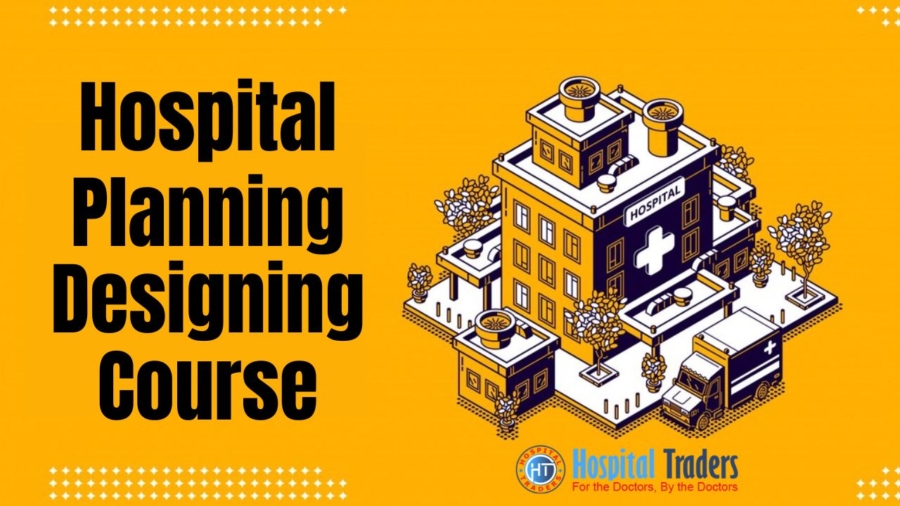In the rapidly evolving landscape of healthcare, the importance of well-designed and efficiently planned hospitals cannot be overstated. As the demand for quality healthcare services continues to grow, the need for skilled professionals in hospital planning and designing becomes increasingly crucial. In this blog post, we explore the significance of hospital planning and designing courses, shedding light on the key elements that contribute to the success of these programs.
The Changing Face of Healthcare Architecture:
Advancements in medical technology, evolving patient needs, and the ever-changing regulatory landscape have transformed the way healthcare facilities are designed and planned. Hospital architects and planners play a pivotal role in creating spaces that optimize patient care, enhance operational efficiency, and provide a healing environment.

The changing face of healthcare architecture is a dynamic landscape shaped by evolving patient needs, technological advancements, and a heightened emphasis on creating healing environments. In this trans formative era, the significance of specialized education, particularly in hospital planning and designing courses, cannot be overstated.
These courses serve as the cornerstone for professionals seeking to navigate the complexities of healthcare architecture. As architects and planners grapple with the integration of cutting-edge technologies, the demand for interdisciplinary expertise becomes increasingly evident.
Hospital planning and designing courses not only address the fundamental principles of effective design but also provide a forward-looking perspective, ensuring that graduates are well-equipped to meet the challenges of designing healthcare facilities that prioritize patient well-being, operational efficiency, and compliance with ever-changing healthcare regulations. The changing face of healthcare architecture necessitates a proactive approach, and hospital planning and designing courses emerge as a crucial tool for architects to shape the future of healthcare spaces.
Why Choose Hospital Planning and Designing Courses?
Choosing hospital planning and designing courses is a strategic decision for individuals aspiring to make a meaningful impact in the field of healthcare architecture. These courses offer a specialized and in-depth exploration of the unique challenges posed by healthcare facility design, providing a comprehensive understanding of evidence-based practices, regulatory compliance, and the integration of advanced technologies.
The interdisciplinary nature of hospital planning and designing courses ensures that graduates gain a holistic perspective, collaborating seamlessly with professionals from various disciplines such as healthcare administration, architecture, and medicine. With a focus on keeping pace with technological advancements, these courses equip individuals to navigate the rapidly evolving landscape of healthcare, incorporating cutting-edge solutions into their designs.
The emphasis on human-eccentric design principles, operational efficiency, and sustainability further distinguishes hospital planning and designing courses, making them an invaluable choice for those seeking to contribute to the future of healthcare architecture.

Opting for hospital planning and designing courses is a strategic choice for individuals aspiring to excel in the dynamic field of healthcare architecture. These courses offer a specialized and comprehensive curriculum that addresses the unique challenges posed by designing healthcare facilities.
By delving into crucial aspects such as evidence-based design, compliance with healthcare regulations, and the integration of advanced technologies, hospital planning and designing courses provide students with a niche skill set. The interdisciplinary nature of these courses ensures that graduates possess a holistic understanding of healthcare architecture, fostering collaboration among professionals from various disciplines.
With a focus on staying abreast of technological advancements and promoting sustainable, human-centric, and resilient design principles, these courses prepare individuals to meet the evolving demands of the healthcare industry. Ultimately, choosing hospital planning and designing courses is a strategic investment in acquiring the specialized expertise needed to make meaningful contributions to the future of healthcare architecture.
Specialized Expertise:
Hospital planning and designing courses equip individuals with specialized knowledge and skills required to address the unique challenges of healthcare architecture. These programs delve into topics such as evidence-based design, healthcare regulations, and the integration of advanced technologies.
Enrolling in hospital planning and designing courses is a strategic pathway to acquiring specialized expertise in the intricate realm of healthcare architecture. These courses delve into the intricacies of designing and planning healthcare facilities, offering a focused curriculum that covers crucial aspects such as evidence-based design, healthcare regulations, and the seamless integration of advanced technologies.
Through these specialized programs, individuals gain a profound understanding of the unique challenges associated with healthcare architecture, equipping themselves with the knowledge and skills necessary to create spaces that optimize patient care, enhance operational efficiency, and foster a healing environment. Hospital planning and designing courses play a pivotal role in cultivating professionals with a niche skill set, empowering them to address the dynamic complexities of healthcare infrastructure and contribute significantly to the advancement of the field.
Interdisciplinary Approach:
Effective hospital planning requires collaboration among professionals from various disciplines, including architects, healthcare administrators, and medical professionals. Courses in hospital planning and designing foster an interdisciplinary approach, ensuring that graduates can navigate the complexities of healthcare projects with a holistic perspective.
Hospital planning and designing courses advocate for an interdisciplinary approach, recognizing the critical need for collaboration among professionals from diverse fields in the complex realm of healthcare architecture. These courses go beyond traditional architectural education, fostering an understanding of the interconnectedness between healthcare administration, architecture, and medical practices. Emphasizing the importance of teamwork, hospital planning and designing courses ensure that graduates possess a holistic perspective, enabling them to navigate the multifaceted challenges inherent in healthcare projects.
The interdisciplinary approach not only enriches the learning experience but also equips professionals with the collaborative skills needed to effectively engage with stakeholders from various disciplines. In this way, individuals completing hospital planning and designing courses are well-prepared to contribute to the seamless integration of architectural principles with the operational and medical requirements of healthcare facilities, ultimately enhancing the overall effectiveness of healthcare infrastructure projects.
Keeping Pace with Technological Advancements:
The integration of cutting-edge technologies, such as telemedicine, smart healthcare systems, and AI-driven diagnostics, is reshaping the healthcare landscape. Hospital planning and designing courses keep professionals abreast of these technological advancements, enabling them to create facilities that are not only state-of-the-art but also future-ready.
Hospital planning and designing courses are instrumental in ensuring that professionals remain at the forefront of healthcare architecture by emphasizing the importance of keeping pace with technological advancements. In an era where innovation in healthcare is rapidly transforming the industry, these courses play a vital role in familiarizing individuals with cutting-edge technologies.
From the integration of telemedicine and smart healthcare systems to the incorporation of artificial intelligence in diagnostics, hospital planning and designing courses provide a comprehensive understanding of the latest technological trends. Graduates are not only equipped with the knowledge to leverage these advancements for improved patient care but are also poised to design healthcare facilities that are future-ready and adaptable to emerging technologies.
By staying abreast of technological breakthroughs, individuals completing hospital planning and designing courses position themselves as invaluable contributors to the evolution of healthcare architecture, ensuring that the facilities they design remain innovative, efficient, and aligned with the changing landscape of healthcare.
Key Components of Hospital Planning and Designing Courses:
Hospital planning and designing courses encompass a comprehensive curriculum that addresses key components crucial for shaping proficient healthcare architects. These specialized courses delve into the intricate aspects of effective hospital design, emphasizing a nuanced understanding of healthcare operations, compliance with rigorous regulations, and the integration of human-eccentric design principles.
Participants in hospital planning and designing courses gain insights into the unique challenges associated with healthcare architecture, including the imperative to create healing environments that prioritize patient well-being and privacy. Additionally, these courses cover the essentials of sustainable and resilient design, ensuring graduates are equipped to develop eco-friendly and adaptable healthcare facilities.
By providing a holistic education that combines technical knowledge with a focus on real-world applications, hospital planning and designing courses stand as a cornerstone for professionals aiming to make significant contributions to the evolving field of healthcare architecture.

The key components of hospital planning and designing courses encompass a comprehensive educational framework designed to equip professionals with the specialized skills required in healthcare architecture. These courses delve into essential aspects such as understanding healthcare operations, ensuring compliance with healthcare regulations, and integrating human-centric design principles.
Participants gain insights into the intricacies of healthcare workflow, emphasizing the optimization of patient care, operational efficiency, and the seamless integration of support services. Hospital planning and designing courses also focus on fostering an interdisciplinary approach, acknowledging the collaborative nature of healthcare projects. Sustainable and resilient design principles are integral components, emphasizing the importance of creating eco-friendly and adaptable healthcare facilities.
By covering these key components, hospital planning and designing courses stand as a foundational resource, shaping architects and planners capable of addressing the unique challenges within the dynamic landscape of healthcare architecture.
Understanding Healthcare Operations:
Courses in hospital planning emphasize the importance of understanding the workflow and operational requirements of healthcare facilities. This includes considerations for patient flow, staff efficiency, and the integration of support services.
Understanding healthcare operations is a pivotal component of hospital planning and designing courses, as it forms the bedrock for creating efficient and patient-centered facilities. These courses delve into the intricacies of healthcare workflow, equipping participants with a profound comprehension of the operational intricacies involved in delivering quality patient care. Hospital planning and designing courses emphasize the importance of optimizing patient flow, enhancing staff efficiency, and integrating support services seamlessly into the overall design.
By focusing on the fundamental principles of healthcare operations, participants in these courses gain insights into the dynamic nature of healthcare delivery, enabling them to design facilities that not only meet regulatory standards but also prioritize the well-being of patients and the effectiveness of medical staff. The emphasis on understanding healthcare operations within hospital planning and designing courses positions professionals to contribute significantly to the creation of healthcare environments that are both functional and patient-centric.
Compliance with Healthcare Regulations:
Healthcare architecture is subject to stringent regulations to ensure patient safety and quality of care. Hospital planning and designing courses provide in-depth knowledge of these regulations, ensuring that graduates can navigate the complex compliance landscape.
Compliance with healthcare regulations is a cornerstone within the curriculum of hospital planning and designing courses, underscoring the critical importance of adhering to stringent standards in healthcare architecture. These specialized courses provide in-depth knowledge of the ever-evolving regulatory landscape, ensuring that participants are well-versed in the intricacies of healthcare guidelines and standards. Hospital planning and designing courses emphasize the significance of designing facilities that not only prioritize patient safety but also align seamlessly with the legal and regulatory frameworks governing healthcare environments.
Professionals completing these courses gain a comprehensive understanding of the compliance requirements, allowing them to navigate complex regulations confidently. By incorporating this key component into the educational framework, hospital planning and designing courses empower architects to create healthcare facilities that not only meet the highest standards of safety and quality but also contribute to the overall advancement of healthcare architecture.
Human-Centric Design Principles:
Creating healing environments involves incorporating human-centric design principles. Hospital planning courses emphasize the significance of designing spaces that promote patient well-being, comfort, and privacy.
Human-centric design principles lie at the heart of hospital planning and designing courses, recognizing the profound impact that the built environment has on patient well-being and healing. These courses emphasize the integration of design elements that prioritize the human experience, ensuring that healthcare facilities go beyond mere functionality to create spaces that are empathetic, comforting, and conducive to healing. By exploring human-centric design principles within hospital planning and designing courses, participants learn to balance aesthetics with functionality, addressing factors such as privacy, accessibility, and the overall patient journey.
The focus on creating environments that promote well-being and reduce stress not only enhances the quality of patient care but also contributes to the overall effectiveness of healthcare facilities. Hospital planning and designing courses, through their emphasis on human-centric design, cultivate architects who understand the profound impact of their work on the individuals within these spaces, ultimately elevating the standard of care provided in healthcare settings.
Sustainable and Resilient Design:
Given the growing focus on sustainability, hospital planning and designing courses address the importance of eco-friendly and resilient design practices. Graduates are equipped to create healthcare facilities that minimize environmental impact and withstand unforeseen challenges.
Sustainable and resilient design principles form a crucial pillar of hospital planning and designing courses, recognizing the imperative to create healthcare facilities that not only meet immediate needs but also withstand the challenges of the future. These specialized courses delve into eco-friendly practices, exploring ways to minimize environmental impact, reduce energy consumption, and incorporate sustainable materials. Hospital planning and designing courses emphasize the integration of resilient design strategies that fortify healthcare infrastructure against unforeseen challenges, ensuring continuity of care in times of crisis.
By instilling a commitment to sustainable and resilient design, these courses equip professionals with the knowledge and skills to create healthcare environments that are both environmentally responsible and capable of adapting to changing circumstances. Through their emphasis on sustainable and resilient design principles, hospital planning and designing courses play a pivotal role in shaping architects who are not only mindful of the immediate needs of patients but also the broader impact of their designs on the community and the planet.
Conclusion:
In conclusion, hospital planning and designing courses are indispensable for professionals seeking to make a meaningful impact in the healthcare sector. As the demand for innovative and efficient healthcare facilities continues to rise, the expertise gained through these courses becomes a valuable asset. By embracing a holistic approach, incorporating the latest technologies, and staying informed about regulatory requirements, graduates of hospital planning and designing courses are well-positioned to shape the future of healthcare architecture.


